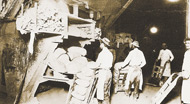History
Cement, a hydraulic binder and a key ingredient in concretes and mortars, came into widespread use during the Industrial Revolution. Learn about the history and innovations which transformed this material into a high-tech product.
In the beginning |
|
|
A mixture of lime, clay, sand and water was used in very ancient constructions. The Egyptians were already using it 2,600 years ago. Around the 1st century, the Romans perfected this "binder". On adding volcanic soil from the region of Pozzuoli, near Naples, they discovered that they could get this mixture to "set" underwater. We now know that the soil from Pozzuoli - which lends its name to pozzolan - is 60 to 90% clay and 10 to 40% lime, depending on the source. Archaeological vestiges from that time, such as cement drains, have been discovered in several Roman cities. |
HydraulicityHydraulicity is the extent to which a material hardens in the presence of water. |
1817: rebirth |
|
|
In 1817, the young engineer Louis Vicat was working on the hydraulic properties of a "lime-volcanic ash" mixture. Louis Vicat was the first to determine in a precise, controlled and reproducible manner the proportions of limestone and silica needed to obtain a mixture which, after burning at a specific temperature and after grinding, produced a hydraulic binder for industrial applications. In other words, cement. However, he published the results of his research without filing for a patent... |
AnecdoteLouis Vicat: genius acknowledged In 1839, Honoré de Balzac wrote in The Village Rector, "What will be the reward of Vicat, the one among us who has brought about the only real progress in the practical science of construction?" Gustave Eiffel engraved Vicat's name alongside those of 71 other illustrious scientists and engineers on the frieze above the first floor of the Eiffel Tower in Paris. |
The 19th century: industrialization |
|
|
Scotsman Joseph Asdin refined the cement composition developed by Louis Vicat and, in 1824, filed a patent for a slower setting cement. He called it Portland, because it bore a resemblance to a type of rock found in the region of Portland in southern England. The first cement plant in France was built in 1846 at Boulogne‑ sur‑Mer. In 1868, Lafarge began producing cement at Teil, in the Ardèche. The use of cement soared with the advent of new, faster processes for cement manufacture. |

Pozzolan and clinkerPozzolan is a volcanic rock which takes its name from the region of Pozzouli, near Naples. It was used by the Romans to make cement. Clinker, the main component of modern cement, is a limestone and clay mixture which is burned at a very high temperature. This reproduces the properties of natural volcanic rock in a factory-made hydraulic binder. |
20th century: innovations signed Lafarge |
|
|
Lafarge was responsible for 2 important discoveries that marked the early 20th century:
Today, Lafarge research and development continues to focus on innovation and works to continually improve the properties of cement. |
BauxiteBauxite is an aluminum ore. It is named after the village of Baux-de-Provence, France, where it was discovered. |





